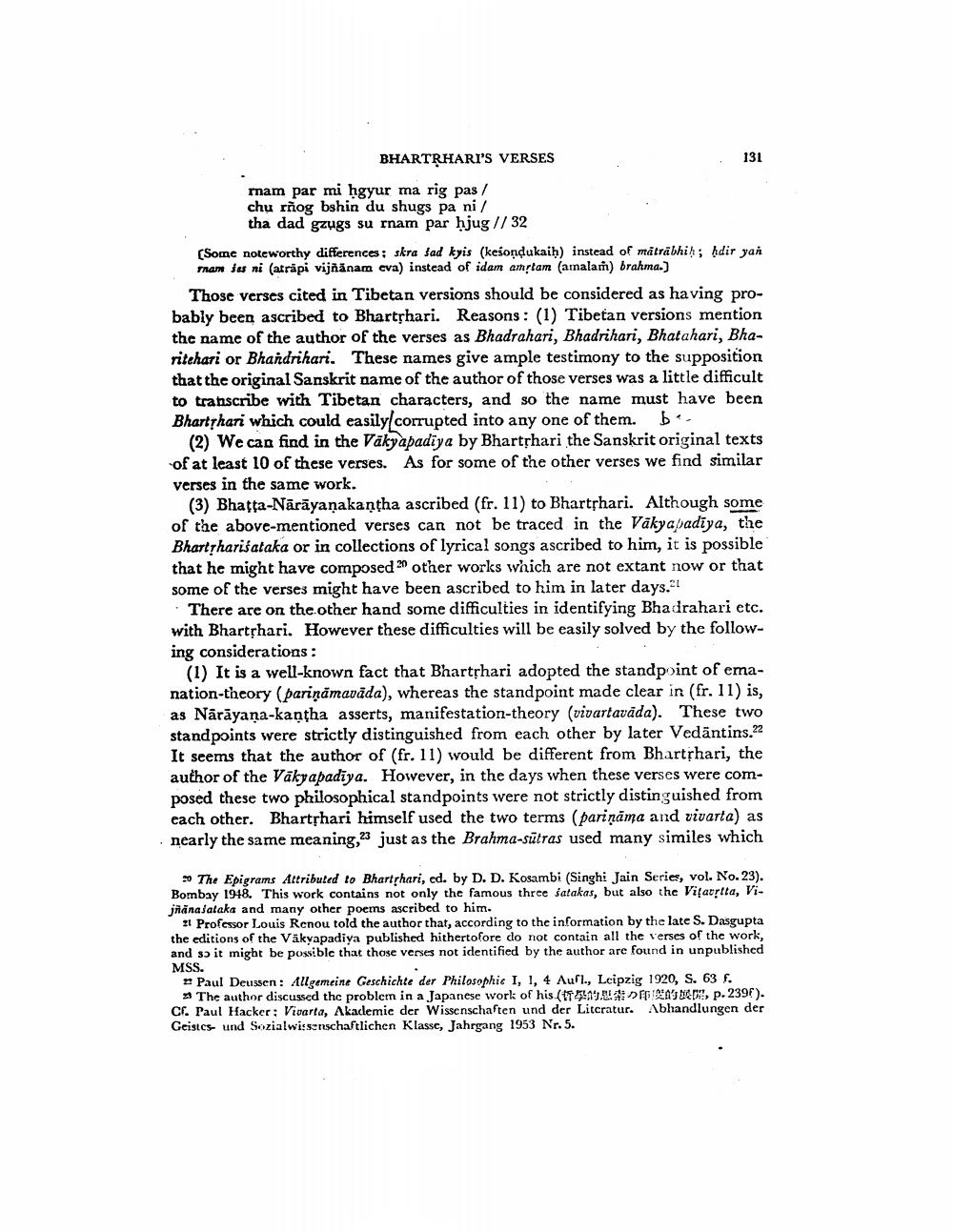________________
BHARTRHARI'S VERSES
131
mam par mi hgyur ma rig pas/ chu rnog bshin du shugs pa ni /
tha dad gzugs su rnam par hjug // 32 (Somc noteworthy differences: skra fad kyis (kesondukaih) instead of mätrabhih; Adir yar Tham ju ni (atrapi vijñānam cva) instead of idam amplam (amalam) brahma.)
Those verses cited in Tibetan versions should be considered as having probably been ascribed to Bharthari. Reasons: (1) Tibetan versions mention the name of the author of the verses as Bhadrahari, Bhadrihari, Bhatahari, Bharitehari or Bhandrihari. These names give ample testimony to the supposition that the original Sanskrit name of the author of those verses was a little difficult to transcribe with Tibetan characters, and so the name must have been Bhartshari which could easily corrupted into any one of them. b.
(2) We can find in the Vakyapadiya by Bharthari the Sanskrit original texts of at least 10 of these verses. As for some of the other verses we find similar verses in the same work.
(3) Bhatta-Nārāyanakantha ascribed (fr. 11) to Bharthari. Although some of the above-mentioned verses can not be traced in the Vakyapadiya, the BhartȚhari ataka or in collections of lyrical songs ascribed to him, it is possible that he might have composed 2 other works which are not extant now or that some of the verses might have been ascribed to him in later days.
There are on the other hand some difficulties in identifying Bhadrahari etc. with Bhartshari. However these difficulties will be easily solved by the following considerations :
(1) It is a well-known fact that Bharthari adopted the standpoint of emanation-theory (pariņāmavāda), whereas the standpoint made clear in (fr. 11) is, as Nārāyana-kantha asserts, manifestation-theory (vivartavāda). These two standpoints were strictly distinguished from each other by later Vedāntins.22 It seems that the author of (fr. 11) would be different from Bhartshari, the author of the Väkyapadiya. However, in the days when these verses were composed these two philosophical standpoints were not strictly distinguished from each other. Bhartshari himself used the two terms (pariņāma and vivarta) as nearly the same meaning, 23 just as the Brahma-sutras used many similes which
30 The Epigrams Attributed to Bharthari, ed. by D. D. Kosambi (Singhi Jain Series, vol. No. 23). Bombay 1918. This work contains not only the famous three Satakas, but also the Vifatpita, Vijñānajataka and many other poems ascribed to him.
Il Professor Louis Rcnou told the author that, according to the information by the late S. Dasgupta the editions of the Vakyapadiya published hithertofore do not contain all the verses of the work, and so it might be possible that those verses not identified by the author are found in unpublished MSS.
Paul Deussen: Allgemeine Geschichte der Philosophic I, I, 4 Auri., Leipzig 1920, S. 63 f.
The author discussed the problem in a Japanese work of his (IT109. D IA'S DEDI p. 2397). Cr. Paul Hacker: Vivarta, Akademic der Wissenschaften und der Literatur. Abhandlungen der Geistes- und Sozialwissenschaftlichen Klasse, Jahrgang 1953 Nr.5.




